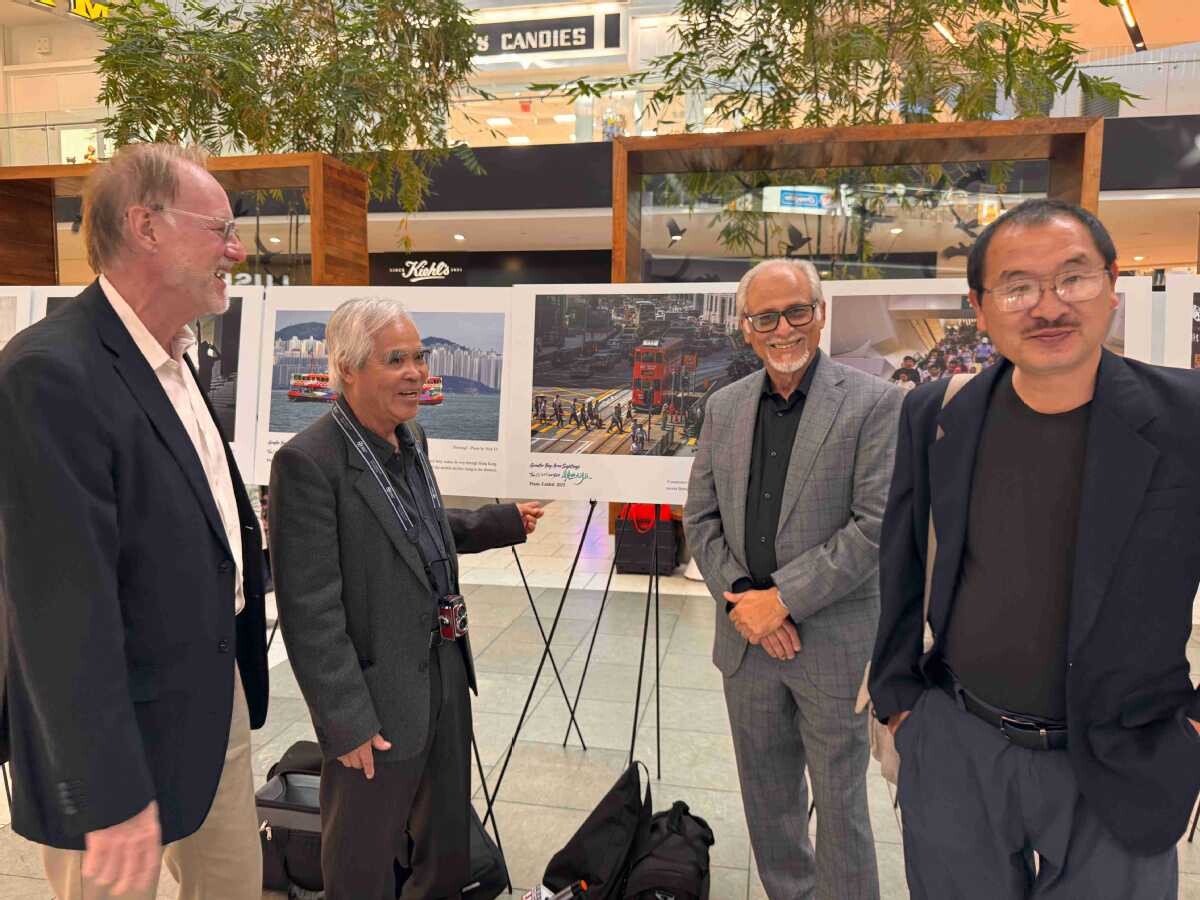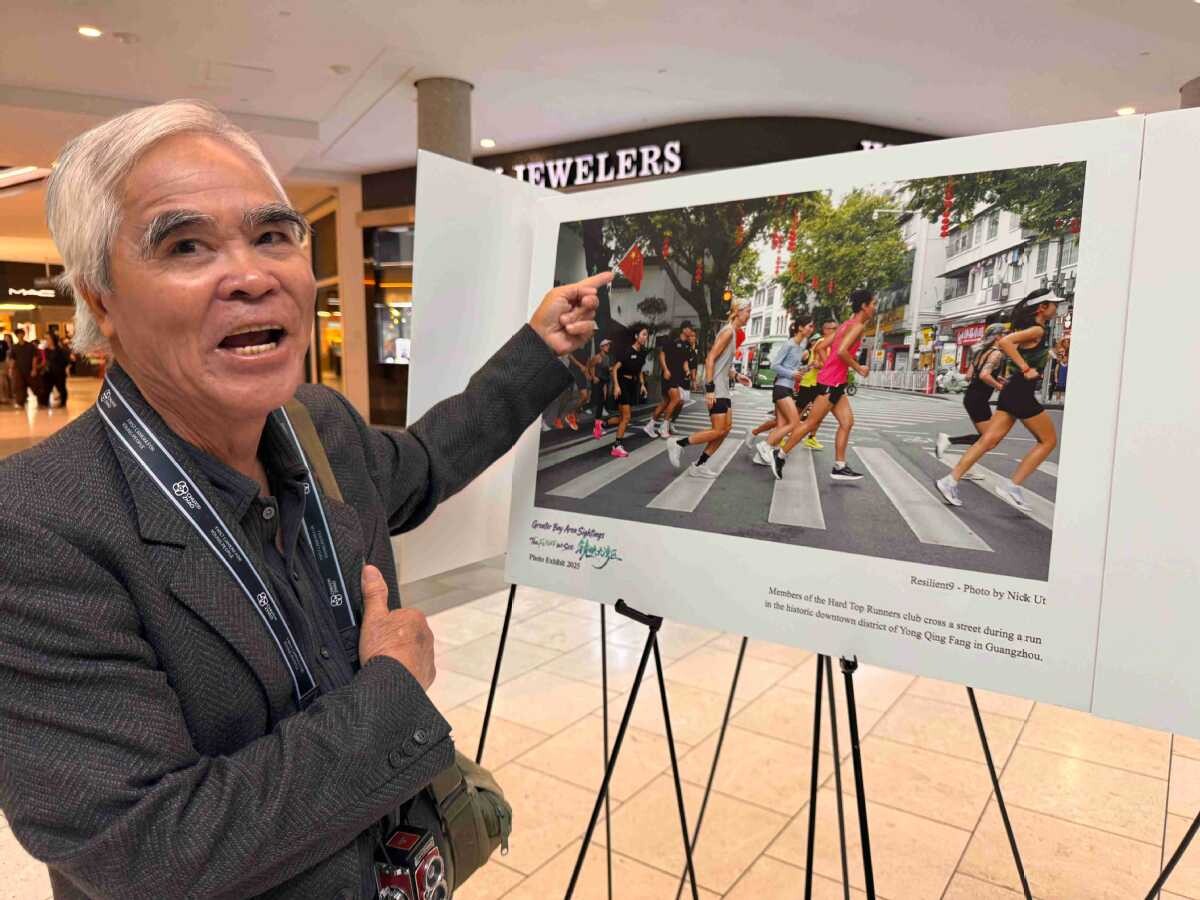 Acclaimed photographers (from left) Michael Nelson, Nick Ut, Irfan Khan and Ringo Chiu at the opening of the photography exhibition The Greater Bay Area Sightings, held at Santa Anita Mall in Arcadia, Los Angeles, on Oct 17. [Photo by RENA LI / CHINA DAILY]
Acclaimed photographers (from left) Michael Nelson, Nick Ut, Irfan Khan and Ringo Chiu at the opening of the photography exhibition The Greater Bay Area Sightings, held at Santa Anita Mall in Arcadia, Los Angeles, on Oct 17. [Photo by RENA LI / CHINA DAILY]
For Nick Ut, the Vietnamese-American photographer best known for his Pulitzer Prize-winning image The Terror of War, traveling to China has become one of his greatest joys since retiring from the Associated Press.
"I have traveled to China many times after retiring from the AP," Ut told China Daily during the opening of the photography exhibition The Greater Bay Area Sightings, held at the Santa Anita Mall in Arcadia, Los Angeles on Friday.
"I went to Shanghai, Beijing, Guangzhou and Hong Kong almost every year. I love China very much. The food, the people, they are very nice."
Having once witnessed the cruelty and inhumanity of war, Ut holds a profound appreciation for peace. Those experiences have made him especially cherish moments of calm and joy, scenes he now seeks to capture through his lens.
Pointing to one of his photographs showing members of a running club crossing a street in the historic Yong Qing Fang district of Guangzhou, Guangdong province, Ut smiled as he noted a Chinese national flag in the background. Nearby, another of his images depicts a father joyfully pedaling three children along Enning Road, where red flags flutter in celebration of China's National Day.

Pulitzer Prize-winning photographer Nick Ut presents his work Resilient, reflecting on his deep appreciation for peace. Pulitzer Prize-winning photographer Nick Ut presents his work Resilient, reflecting on his deep appreciation for peace.
"You cannot imagine how happy the father is," Ut said. "It's peaceful and safe there, no war at all."
The exhibition, themed "Reflections of the Greater Bay Area: The Future City Through Our Eyes," showcases the perspectives of five acclaimed photographers — Ut, Irfan Khan, Ringo Chiu, Michael Nelson and Sarah Reingewirtz — following their recent journey through the Guangdong-Hong Kong-Macao Greater Bay Area.
In September, the group traveled across one of China's most dynamic and innovative regions, visiting key cities such as Hong Kong, Macao, Shenzhen and Guangzhou. Through their lenses, they sought to capture the energy, beauty and potential of a region that reflects China's path toward modernization and openness.
Khan, a veteran photographer who worked with the Los Angeles Times and was a member of a Pulitzer Prize-winning team, presented two pieces that reflect contrasting yet complementary sides of modern China.
One of his works, Unseen, portrays a young woman resting peacefully with her camera in her lap on a sunny afternoon at Victoria Peak in Hong Kong.
"I call it a picture of serenity," Khan said. "She's a modern Chinese young lady, completely at ease in her surroundings. Despite the crowd around her, she appears lost in her own peaceful world. To me, this image reflects mobility, peace, safety and beauty, all in one frame."
In another photograph, Khan captures the vibrant nightlife of Guangzhou.
"This photo shows affluence, energy, youth and color; it captures everything that China represents today," he said. "People are enjoying themselves, sharing amazing food and drinks in a lively atmosphere. That tells you something: economically they are doing well, financially they are doing well."
The exhibition's curatorial theme, "FUTURE," unfolds through six key words: Flowing, Unseen, Tech-driven, Unique, Resilient and Enjoyable, each represented by works from the participating photographers.
In one image presented by Pulitzer Prize-winning photographer Chiu, an Olympic torch sculpture stands tall on the Tsim Sha Tsui waterfront, illuminated by the skyline of Hong Kong Island.
"What I want to express is that Hong Kong has always been a lively and bustling place," said Chiu, who is the first Hong Kong-born Chinese photojournalist to win the Pulitzer Prize.
"The torch reflects the central government. We hope for deeper integration across the GBA, linking Hong Kong, Guangdong and neighboring cities to further revitalize Hong Kong's economy."
Chiu's other photograph shows a staff member working inside the intelligent control center at Guangzhou Port — the bustling harbor can be seen with the region's technological sophistication and economic strength.
"I love these pictures of Guangzhou Port," said Stefanie, a visitor to the exhibition. "It looks just like our Port of Long Beach."
Nelson, chief photographer for Agence France-Presse in the western United States, contributed one of his favorite pieces, Flowing, taken in Hong Kong.
"This is one of my favorite photos because it captures people exercising to music against the backdrop of Hong Kong's iconic skyline," Nelson said. "The movement and rhythm give it an artistic quality. It's a silhouette photograph, which I think adds to its energy and style."
For Nelson, the image carries deep personal meaning. "I first visited Hong Kong about 60 years ago, during a typhoon, when my uncle, aunt and cousins were living and working there," he recalled. "So returning to photograph the city decades later brought back many memories."
He said Flowing also reflects his admiration for China's rapid modernization. "The building in the background is the Henderson, an example of very innovative architecture," he said. "I've been struck by the creativity and modernity of its urban design. Cities like Guangzhou, for instance, light up their skyscrapers beautifully at night, creating a truly stunning visual scene."
Ou Linlin, deputy director at Guangdong Radio and Television, said the exhibition aims to present the GBA in a global context through the universal language of photography.
"What does the future urban landscape look like? Today, these images provide rich and multifaceted answers," Ou said.
Grace Chung from R & C Media Group said the exhibition brings the idea of "future cities" to life in a relatable way.
"Through these lenses, 'future cities' become a reality we can relate to," Chung said. "These works allow us to see the story of the GBA as part of the broader global conversation on shared human development."
















